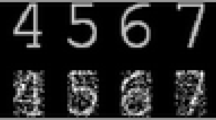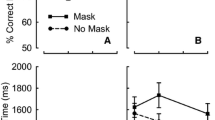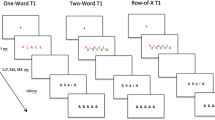Abstract
When two targets are embedded in a temporal stream of distractors, second-target identification is initially impaired and then gradually improves as inter-target interval lengthens (attentional blink; AB). Notably, in about half of the published studies, this deficit is partially ameliorated when the targets follow one another directly, a condition known as “lag-1 sparing”. Here, we probe the impact of target-distractor similarity on lag-1 sparing, with the surprising finding that while high similarity impairs second-target accuracy at all subsequent lags, it actually improves accuracy when the targets follow one another directly. We suggest that this improvement reflects the positive influence of over-committing resources to target processing in the AB.



Similar content being viewed by others
References
Akyürek, E. G., & Hommel, B. (2005). Target integration and the attentional blink. Acta Psychologica, 119, 305–314.
Broadbent, D. E., & Broadbent, M. H. (1987). From detection to identification: Response to multiple targets in rapid serial visual presentation. Perception & Psychophysics, 42, 105–113.
Chun, M. M., & Potter, M. C. (1995). A two-stage model for multiple target detection in rapid serial visual presentation. Journal of Experimental Psychology: Human Perception and Performance, 21, 109–127.
Dell’Acqua, R., Jolicoeur, P., & Pascali, A. (2007). Short term consolidation of individual identities leads to Lag-1 sparing. Journal of Experimental Psychology: Human Perception and Performance, 33, 593–609.
Di Lollo, V., Kawahara, J., Ghorashi, S., & Enns, J. (2005). The attentional blink: Resource depletion or temporary loss of control? Psychological Research, 69, 191–200.
Ferlazzo, F., Lucido, S., Di Nocera, F., Fagioli, S., & Sdoia, S. (2007). Switching between goals mediates the attentional blink effect. Experimental Psychology, 54, 89–98.
Folk, C. L., Leber, A. B., & Egeth, H. E. (2002). Made you blink! Contingent attentional capture produces a spatial blink. Perception & Psychophysics, 64, 741–753.
Ghorashi, S. M. S., Zuvic, S. M., Visser, T. A. W., & Di Lollo, V. (2003). Focal distraction: Spatial shifts of attentional focus are not required for contingent capture. Journal of Experimental Psychology: Human Perception and Performance, 29(1), 78–91.
Giesbrecht, B., & Di Lollo, V. (1998). Beyond the attentional blink: Visual masking by object substation. Journal of Experimental Psychology: Human Perception and Performance, 24, 1454–1466.
Hommel, B., Kessler, K., Schmitz, F., Gross, J., Akyurek, E., Shapiro, K., et al. (2006). How the brain blinks: Towards a neurocognitive model of the attentional blink. Psychological Research, 70, 425–435.
Isaak, M. I., Shapiro, K. L., & Martin, J. (1999). The attentional blink effects retrieval competition among multiple rapid several visual presentation items: Tests of an interference model. Journal of Experimental Psychology: Human Perception and Performance, 25, 1774–1792.
Jolicoeur, P. (1998). Modulation of the attentional blink by on-line response selection: Evidence from speeded and unspeeded Task-sub-1 decisions. Memory & Cognition, 26, 1014–1032.
Kawahara, J., Kumada, T., & Di Lollo, V. (2006a). The attentional blink is governed by a temporary loss of control. Psychonomic Bulletin & Review, 13, 886–890.
Kawahara, J., Enns, J., & Di Lollo, V. (2006b). The attentional blink is not a unitary phenomenon. Psychological Research, 70, 405–413.
Luck, S. J., Vogel, E. K., & Shapiro, K. L. (1996). Word meanings can be accessed but not reported during the attentional blink. Nature, 383, 616–618.
Maki, W. S., Bussard, G., Lopez, K., & Digby, B. (2003). Sources of interference in the attentional blink: Target-distractor similarity revisited. Perception & Psychophysics, 65, 188–201.
Neurobehavioral Systems (2002). Presentation Version 0.81(online). http://www.neuro-bs.com. Accessed 25 November 2004.
Olivers, C., & Nieuwenhuis, S. (2005). The beneficial effect of concurrent task-irrelevant mental activity on temporal attention. Psychological Science, 16, 265–269.
Olivers, C., & Nieuwenhuis, S. (2006). The beneficial effects of additional task load, positive affect, and instruction on the attentional blink. Journal of Experimental Psychology: Human Perception and Performance, 32, 364–379.
Olivers, C., van der Stigchel, S., & Hulleman, J. (2007). Spreading the sparing: Against a limited-capacity account of the attentional blink. Psychological Research, 71, 126–139.
Potter, M. C., Chun, M. M., Banks, B. S., & Muckenhoupt, M. (1998). Two attentional deficits in serial target search: The visual attentional blink and an amodal task-switch deficit. Journal of Experimental Psychology: Learning, Memory, and Cognition, 24, 979–992.
Potter, M. C., Staub, A., & O’Connor, D. H. (2002). The time course of competition for attention: Attention is initially labile. Journal of Experimental Psychology: Human Perception and Performance, 28, 1149–1162.
Raymond, J. E., Shapiro, K. L., & Arnell, K. M. (1992). Temporary suppression of visual processing in an RSVP task: An attentional blink? Journal of Experimental Psychology: Human Perception and Performance, 18, 849–860.
Shapiro, K. L. & Raymond, J. E. (1994). Temporal allocation of visual attention: Inhibition or interference? In: D. Dagenbach and T. Carr (Eds.) Inhibitory processes in attention, memory, and language. San Diego: Academic Press, Inc.
Shapiro, K. L., Caldwell, J., & Sorensen, R. E. (1997). Personal names and the attentional blink: A visual “cocktail party” effect. Journal of Experimental Psychology: Human Perception and Performance, 23, 504–514.
Shih, S. (2000). Recall of two visual targets embedded in RSVP streams of distracters depends on their temporal and spatial relationship. Perception & Psychophysics, 62, 1348–1355.
Visser, T. A. W., Bischof, W. F., & Di Lollo, V. (1999a). Attentional switching in spatial and nonspatial domains: Evidence from the attentional blink. Psychological Bulletin, 125, 458–469.
Visser, T. A. W., Zuvic, S. M., Bischof, W. F., & Di Lollo, V. (1999b). The attentional blink with targets in different spatial locations. Psychonomic Bulletin and Review, 6, 432–436.
Visser, T. A. W., Boden, C., & Giaschi, D. E. (2004a). Children with dyslexia: Evidence for visual attention deficits in perception of rapid sequences of objects. Vision Research, 44, 2521–2535.
Visser, T. A. W., Bischof, W. F., & Di Lollo, V. (2004b). Rapid serial visual distraction: Task irrelevant items can produce an attentional blink. Perception and Psychophysics, 66, 1418–1432.
Acknowledgments
This work was supported by an Early Career Research Grant from the University of Melbourne, a Discovery Grant from the Australian Research Council, and seed funding from the University of British Columbia, Okanagan. Portions of the findings were reported at the 45th Annual Meeting of the Psychonomic Society, Minneapolis, MN, November 2004. The authors wish to thank several anonymous reviewers, Chris Olivers, and Fabio Ferlazzo for their helpful comments on previous versions of this manuscript.
Author information
Authors and Affiliations
Corresponding author
Rights and permissions
About this article
Cite this article
Visser, T.A.W., Davis, C. & Ohan, J.L. When similarity leads to sparing: probing mechanisms underlying the attentional blink. Psychological Research 73, 327–335 (2009). https://doi.org/10.1007/s00426-008-0155-5
Received:
Accepted:
Published:
Issue Date:
DOI: https://doi.org/10.1007/s00426-008-0155-5




